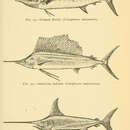en
names in breadcrumbs


Striped marlin may communicate visually with conspecifics via use of their chromatophores. Such communication may be used to signal spawning readiness. Like other teleost fishes, striped marlin have olfactory nares to detect chemicals in the water, helping them find mates or prey. They also have large eyes which enable them to hunt at night or at depths with low levels of light. The lateral line, running along the sides of the fish, senses pressure differences and heightens its awareness of its surroundings.
Communication Channels: visual ; chemical
Perception Channels: visual ; tactile ; acoustic ; vibrations ; chemical
It is estimated that populations of striped marlin have declined by 20-25% since the mid 1990s. More detailed and frequent stock assessments in the Indian Ocean as well as the northwest Pacific Ocean need to be conducted to obtain basic biological information on this species for its effective management.
US Federal List: no special status
CITES: no special status
State of Michigan List: no special status
After spawning has occurred, fertilized eggs develop into planktonic, lecithotropic larvae that drift for several weeks to months before the larvae develop into small fry. Little is known specifically about the early life stages of this species.
Development - Life Cycle: indeterminate growth
There are no known adverse effects of striped marlin on humans, though eating striped marlin and other large predatory fishes may put people at risk of illness due to high levels of mercury retained within the fish's muscle tissue.
Striped marlin fight when caught by hook and line, providing sport fishermen with recreational opportunities. Catch and release of this species is recommended in waters of the United States. While this species is not usually consumed in the United States, it is considered a delicacy in Asia.
Positive Impacts: food ; ecotourism
Striped marlin have an important role in the epipelagic marine food chain as apex predators, helping to regulate the population of cephalopods and fish. Furthermore, this species hosts a number of parasites, including copepods and a variety of flatworm species.
Commensal/Parasitic Species:
Planktonic larvae and small juveniles consume zooplankton. Dietary analysis of adult striped marlin during a yearly cycle in the southern Gulf of California, Mexico, found prey consisting of epipelagic organisms from the neritic and oceanic zones. The most abundant prey noted were chub mackerel (Scomber japonicas), California pilchard (Sardinops sagax) and jumbo squid (Dosidicus gigas).
Animal Foods: fish; mollusks; other marine invertebrates; zooplankton
Primary Diet: carnivore (Piscivore , Molluscivore ); planktivore
Striped marlin are pelagic billfish native to the Indian and Pacific oceans. They are found in coastal waters offshore of Africa, Mexico, South America, and New Zealand. In North American waters, Striped marlin are most common south of Point Conception, California, but range as far north as Oregon.
Biogeographic Regions: indian ocean (Native ); pacific ocean (Native )
Striped marlin inhabit pelagic waters and their population density is positively correlated with distance from shore. These fish are generally found in the epipelagic zone.
Range depth: 0 to 200 m.
Habitat Regions: temperate ; tropical ; saltwater or marine
Aquatic Biomes: pelagic ; coastal
Striped marlin live from 8 to 10 years. They are not maintained in captivity.
Range lifespan
Status: wild: 8 to 10 years.
Typical lifespan
Status: wild: 8 to 10 years.
Striped marlin are bony fish that are similar in appearance to sailfish, with a distinguishable difference in the dorsal fin (in Striped marlin the dorsal fin is much smaller and tapers toward the caudle peduncle). With a fusiform-shaped body, striped marlin glide through the water with little resistance. Striped marlin have the thinnest bill amongst all billfishes and slash their prey as opposed to impaling them as other members of the family do. Striped marlin have a distinct color patterning of 10-20 blue bars extending from the head and continuing to the caudal fin. When the fish is excited, the coloration of these bars rapidly changes from blue to lavender via the contraction or expansion of chromatophores (special pigmented cells in the integument).
Range mass: 224 (high) kg.
Range length: 3.35 (high) m.
Other Physical Features: endothermic ; bilateral symmetry
Sexual Dimorphism: female larger
The only known predators of this species are great white sharks, killer whales, and humans.
Known Predators:
Anti-predator Adaptations: cryptic
Striped marlin form groups and/or schools during their reproductive season. As a broadcast spawning species, males and females potentially have multiple mates. Further information regarding courtship behavior is currently unavailable.
Mating System: polygynandrous (promiscuous)
Female striped marlin reach sexual maturity at 1.5-2.5 years of age while males reach sexual maturity at 1-2 years of age. Striped marlin reproduce by broadcast spawning (the female releases eggs which are fertilized in the water column). Females may produce 11-29 million eggs annually.
Breeding interval: Striped marlin spawn annually.
Breeding season: Striped marlin spawn during the months of November and December
Range number of offspring: 11 million to 29 million.
Range age at sexual or reproductive maturity (female): 1.5 to 2.5 years.
Range age at sexual or reproductive maturity (male): 1 to 2 years.
Key Reproductive Features: iteroparous ; seasonal breeding ; gonochoric/gonochoristic/dioecious (sexes separate); sexual ; fertilization (External ); broadcast (group) spawning; oviparous
Gametes are shed into the water during spawning; there is no further parental care.
Parental Investment: no parental involvement